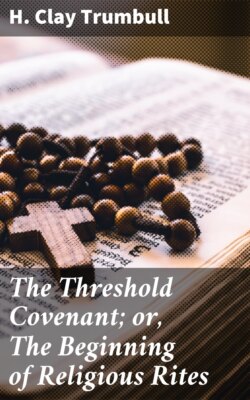Читать книгу The Threshold Covenant; or, The Beginning of Religious Rites - H. Clay Trumbull - Страница 14
На сайте Литреса книга снята с продажи.
9. DEITIES OF THE DOORWAY.
ОглавлениеTable of Contents
Originally the covenant sacrifice at the threshold was with the one God of life. But as monotheism degenerated into polytheism, the idea came to prevail of different deities in different portions of the door, or of different deities in different districts of country or in different offices of life.
Each gate of an Assyrian city was dedicated to a special god, and named after it,–as the gate of Bel, the gate of Beltis, the gate of Anu, the gate of Ishtar. At the entrance-way of every gate gigantic winged bulls with human heads stood on guard, accompanied by winged genii.[251] And the central doorway to the king’s palace was similarly guarded.[252] In every house a special deity was appealed to at different portions of the doorway; Nergal on the top of the wall and beneath the threshold; Ea and Merodach in the passage to the right and left of the gate.[253]
The idea of an offering, or of a dedication, to the local divinity, at the time the threshold is laid, is of wide acceptance. In India, “the god Vāttu, or Vāttuma [a son of Vishnoo], is said to recline and live in the threshold, changing his position every month. … On the day when the door-frame and threshold of a new house or temple are fixed, the Vāttuma santhe [the tribute to Vāttuma] is offered.”[254]
In China, “Shintu and Yuhlui are named as two tutelar gods to whom the guardianship of the house is entrusted; and either the names or grotesque representations of these ‘gods of the threshold’ are at the gate of the house, with shrines to them upon the left of the entrance way.”[255]
It is said of these “Chinese gods of the threshold,” that “in full stature, and presumably in primeval strength, they flank the doors of monasteries and the entrances to the halls of justice. Much reduced in size and perched high on shelves, they face each other in the vestibules of the Chinese home; and in their most diminutive aspect they become little images, occasionally two-headed, which are carried about the person as charms, or hang from the eaves of Chinese houses.”[256]
Over the doors of almost all the houses of Japan are to be seen small prints of the “gigantic Ni-o, the Booddhist Gog and Magog,” who are supposed to guard the entrance way of the holy places.[257] Private buildings as well as public need this spiritual protection.
The inscriptions at the doorways of the houses of ancient Egypt showed that every building was “placed under the protection of a tutelary deity.” This custom “is retained by the modern Egyptians in the protecting genius said to preside over the different quarters of Cairo.”[258]
Tertullian, a Christian Father who wrote before the close of the second century, in warning believers against the seducements of idolatry, emphasized the clustering of deities at the doors and gates in the religions of Greece and Rome.[259] He says that “among the Greeks … we read of Apollo Thyræus (that is, of the door), and the Antelii (or, Anthelii) demons, as presiders over entrances;” while among the Romans there are other “gods of entrances; Cardea (Hinge-goddess), called after hinges; and Forculus (Door-god) after doors; and Limentinus (Threshold-god) after the threshold; and Janus (Gate-god) himself after the gate.”
Although a Christian might not recognize these gods as gods, he is told to beware lest he seem to give them honor by adorning his gates with lamps or wreaths. “Indeed, a Christian will not even dishonor his own gate with laurel crowns,” says Tertullian, “if so be he knows how many gods the devil has attached to doors.” And his words of warning are: “Since there are beings who are adored in entrances [doorways], it is to them that both the lamps and laurels will pertain. To an idol you will have done whatever you shall have done to an entrance [or doorway].” “If you have renounced [heathen] temples, make not your own gate a [heathen] temple.” Yet, in proof of the prevalence of this heathen custom among Christians, Tertullian testifies: “ ‘Let your works shine,’ says He; but now all our shops and gates shine! You will now-a-days find more doors of heathens without lamps and laurel-wreaths than of Christians.”
In Guatemala, in Central America, “the god of houses” is called Chahalka; and the blood of sacrifices to him is sprinkled on the door of the houses as an assurance of his protection.[260]
It was much the same in the Old World as in the New. In ancient and in modern times, and in widely different portions of the world, there are indications that the threshold of the home was the primitive altar; and that the side-posts and lintel of the doorway above the threshold bore symbols or inscriptions in proof of the sacredness of the entrance to the family home, and in token of an accomplished covenant with its guardian God, or gods.
